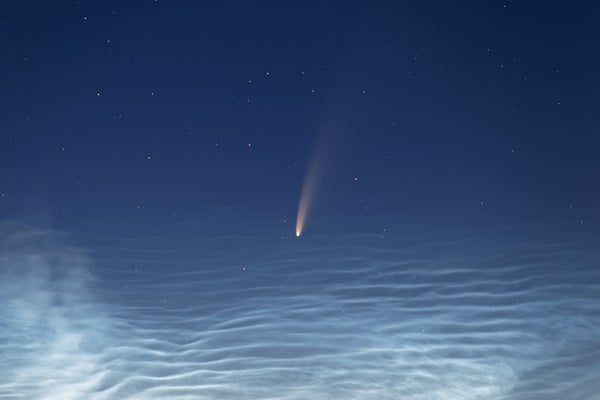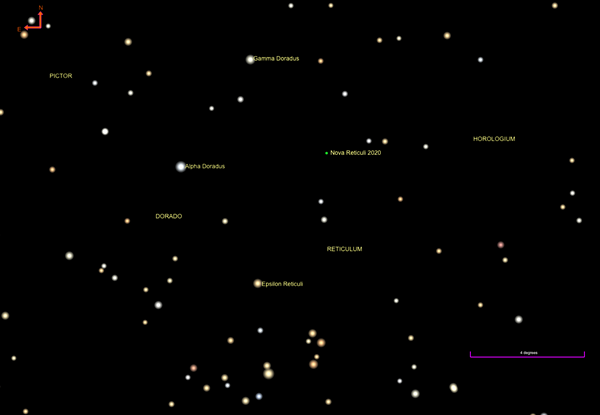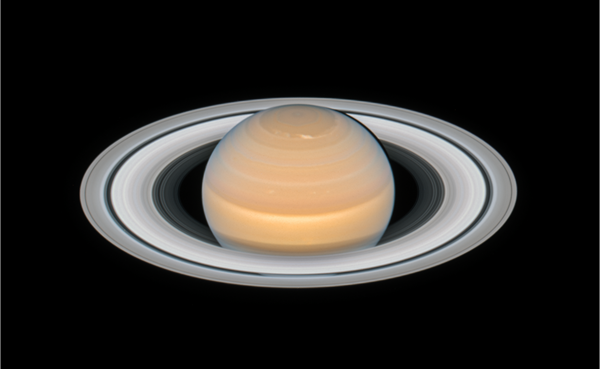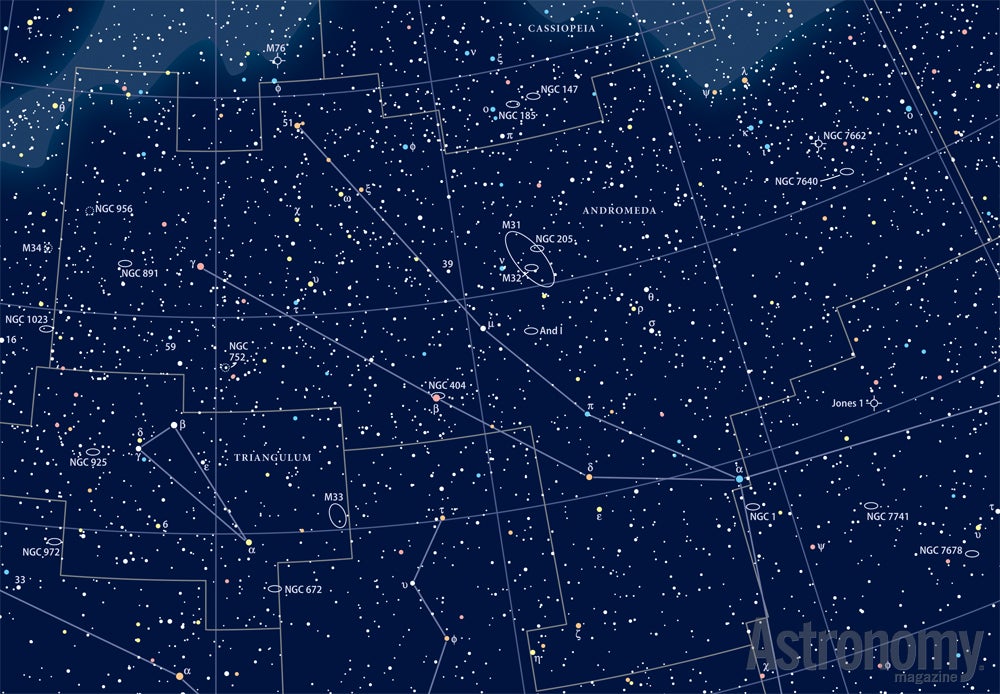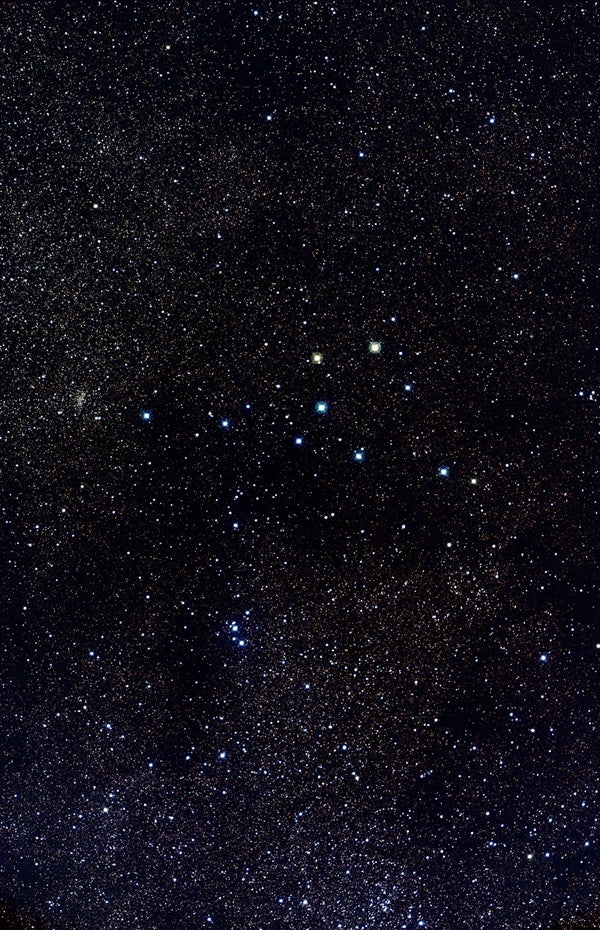Comet C/2020 F3 (NEOWISE) has now established itself as a fine early-evening object. At sunset tonight, it is nearly 25° above the northwestern horizon for observers at northern latitudes. It’s still about 16.5° high an hour later. Currently observed to be magnitude 1.6, its fuzzy, 2.3′-wide coma and perhaps a bit of its fainter tail may be visible to the naked eye from a dark location. To really bring out the comet’s beauty, you’ll want binoculars or a small scope. Look for it about 23° west (below) Merak, the star that marks the lower righthand corner of the Big Dipper’s cup.
The comet will continue to appear higher each night relative to the day before, traveling upward to slide beneath the cup of the Big Dipper. Its closest approach to Earth is still upcoming on July 23, when it passes within 64.1 million miles (103.2 million kilometers) of our planet.
According to recent observations, the nova is still about magnitude 5, visible without optical aid. It will look like a star where you don’t expect to see one. If you’re having trouble finding it by eye or live in a light-polluted location, binoculars or a telescope should show it easily.

Astronomy is pleased to present The Complete Star Atlas, the perfect resource for stargazers of all ages. This practical guide to viewing the night sky is now available, and includes approximately 87,000 stars, 1,200 deep-sky objects, and 24 high-quality star maps. You’ll also find 50 pages of astronomy history, tips, and more from experienced Contributing Editor Michael E. Bakich.
The Moon and Mercury lie close together in this morning’s sky, just over 9° apart an hour before sunrise. Mercury is low in the northeast, rising higher as dawn approaches. Shining at magnitude 0.9, its disk is 26 percent illuminated and just 9″ across. The waning Moon is a mere 6 percent illuminated.
Presenting an easier target, Venus is also nearby, nearly 20° high in the east. It’s a blazing magnitude –4.7, far outshining orange Aldebaran about 4° to its west in Taurus the Bull. The Moon will pass close to Venus later in the week.
The Moon passes 4° north of Mercury at midnight EDT tonight, although the pair is below the horizon when this occurs.
Sunday, July 19
In honor of the recent images released by Solar Orbiter, consider trying your hand at solar observing today — with the right equipment, of course. A specialized solar filter or solar scope can reveal features including sunspots and prominences, while using solar projection can allow you to sketch sunspots just as Galileo did. (For a great tutorial on solar projection, check out this 2009 column by Astronomy contributor Glenn Chaple.)
Regardless of how you choose to observe the Sun, always observe safely. Never look directly at the Sun with or without a telescope unless you have a properly rated filter or other specialized protective equipment. Even then, remember that elements such as your finder scope are not filtered and don’t use them to center your scope.
New Moon occurs at 1:33 P.M. EDT.
Saturn reaches at opposition at 6 P.M. EDT, when it will lie 836 million miles (1.35 billion kilometers) from Earth. As soon as the Sun sets, the ringed planet is rising in the southeast, with Jupiter about 7° to its west. Saturn glows at an easy magnitude 0.1 for observers without optical aid, but binoculars or a telescope will bring into view its stunning rings. They stretch nearly 42″ across, more than twice the diameter of the planet’s 19″-wide disk. As full darkness falls, see if you can spot the rings’ dark Cassini Division or the planet’s bright moon Titan, nearly 3′ east of Saturn’s center.
Saturn lies in the constellation Sagittarius, and the region around it is rich with additional observing targets tonight. These include Jupiter, Pluto, and the globular clusters M55 and M75. With no Moon to create glare, these and other faint objects should be easier to spot and appear grander against the dark-sky backdrop.
Tuesday, July 21
Summertime is the best time to try spotting noctilucent, or night-shining, clouds. These wispy, eerie clouds hang high in Earth’s atmosphere — about 50 miles (80 km) above the surface, far higher than the lower atmosphere where other clouds and weather occur. Noctilucent clouds comprise ice crystals that form on dust grains high in the atmosphere, which are then illuminated by the Sun. Because of their height, these clouds can reflect light long after the Sun has set (or before it rises) from an observer’s location.
Wednesday, July 22
The Southern Delta Aquariid meteor shower is now ramping up for its peak on July 29, when observers can expect about 20 shower meteors per hour. In fact, the shower has been active most of the month, officially starting on the 12th. As the date of the peak approaches, you may notice more and more sporadic meteors in the sky, particularly if you observe for long periods of time from a dark site. The shower’s radiant in Aquarius the Water-bearer rises late in the evening and is visible all morning until sunrise, climbing higher in the sky. To find it, locate bright Jupiter and Saturn, then scan about 35° east of a point roughly between the two planets. With New Moon now past, the next several days are an ideal time to watch for meteors. The best time to look is early morning, before dawn starts to brighten the sky.
Mercury is at greatest western elongation (20°) at 11 A.M. EDT.
With no Moon in the sky, early this morning is a great time to look for the Milky Way’s largest neighbor, the Andromeda Galaxy (M31). You’ll find the constellation Andromeda rising in the northeast after midnight; our sister spiral galaxy is roughly in the middle of the constellation’s delineated region on the sky, just under 8° northwest of magnitude 2.1 Mirach. From a dark location and once the constellation is high enough in the sky, you may spot M31 without any optical aid as a faint, fuzzy patch of light. Try using averted vision — look just to the left or right of where the galaxy should be and it may pop into view of your peripheral vision, which is more sensitive to dim objects.
M31 is a fantastic binocular or telescope target as well, covering about 178′ by 63′. If you’ve got clear skies, consider searching out two of the galaxy’s smaller companions with your binoculars or telescope as well: M32 (magnitude 8.2) and M110 (magnitude 8). M32 is a small dwarf elliptical galaxy located just south of the Andromeda Galaxy. M110 is just north of the large spiral and, despite its slightly brighter magnitude, is often considered a harder challenge than M32. That’s because M110 is a bit larger (17′ by 10′) than M32 (8′ by 6′), which spreads M110’s light out over a larger area and makes it appear fainter.
By the time darkness falls tonight, the famous Coathanger asterism, which is part of Brocchi’s Cluster (also called Collinder 399), is high in the sky. Located in Vulpecula the Fox, this 90′-wide grouping of stars is 4° northwest of Alpha (α) Sagittae. Observers with excellent eyesight may see it unaided as a magnitude 3.5 “mist” against the backdrop of the Milky Way’s plane. If you want to challenge yourself, try using averted vision on that fuzzy patch — you may ultimately spot the Coathanger’s brightest members, which range between 5th and 7th magnitude. At least five of its stars are brighter than magnitude 6.3.
Regardless of your eyesight, the familiar coathanger shape of the asterism appears easily with binoculars or a small telescope. You’ll see six stars oriented east-west forming the line of the hanger, with four stars in the middle creating the hook to the south.

Our exclusive Sky Guide 2020 is now available! This free downloadable pamphlet contains a month-by-month rundown of 2020’s biggest celestial events, from Mars’ best opposition in years to the return of totality in South America this December. Check out Astronomy’s Sky Guide 2020 now!

